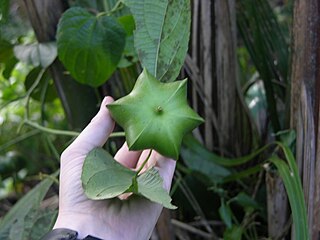Related Research Articles

The Malpighiales comprise one of the largest orders of flowering plants, containing about 36 families and more than 16,000 species, about 7.8% of the eudicots. The order is very diverse, containing plants as different as the willow, violet, poinsettia, manchineel, rafflesia and coca plant, and are hard to recognize except with molecular phylogenetic evidence. It is not part of any of the classification systems based only on plant morphology. Molecular clock calculations estimate the origin of stem group Malpighiales at around 100 million years ago (Mya) and the origin of crown group Malpighiales at about 90 Mya.

Phyllanthaceae is a family of flowering plants in the eudicot order Malpighiales. It is most closely related to the family Picrodendraceae.

The family Pandaceae consists of three genera that were formerly recognized in the Euphorbiaceae. Those are:

The Acalyphoideae are a subfamily within the family Euphorbiaceae with 116 genera in 20 tribes.

Aleuritideae is a tribe of the subfamily Crotonoideae, under the family Euphorbiaceae. It comprises 6 subtribes and 14 genera.

Adelieae is a tribe of the subfamily Acalyphoideae, under the family Euphorbiaceae. It comprises 5 genera.

Plukenetieae is a tribe of plant of the family Euphorbiaceae. It comprises 3 subtribes and 14 genera. Tribe Plukenetieae (Benth.) Hutch. is a diverse pantropical lineage of ca. 17 genera and 350 species of twining vines and lianas, scandent to erect perennial herbs and subshrubs, and rarely shrubs and small trees.

Hippomaneae is a tribe of flowering plants of the family Euphorbiaceae. It comprises 2 subtribes and 33 genera.
Lasiocroton is a plant genus of the family Euphorbiaceae first described as a genus in 1859. The genus is endemic to the West Indies. It is a member of the Leucocroton alliance, which also includes Leucocroton and Garciadelia. Species in this alliance are dioecious.
- Lasiocroton bahamensisPax & K.Hoffm. - Bahamas, Cuba, Haiti
- Lasiocroton fawcettiiUrb. - Jamaica
- Lasiocroton gracilisBritton & P.Wilson - SE Cuba
- Lasiocroton gutierreziiJestrow - Cuba
- Lasiocroton harrisiiBritton - Jamaica
- Lasiocroton macrophyllus(Sw.) Griseb. - Jamaica
- Lasiocroton microphyllus(A.Rich.) Jestrow - Cuba
- moved to other genera (Bernardia Croton Leucocroton)
- Lasiocroton cordifoliusBritton & P.Wilson - Leucocroton cordifolius (Britton & P.Wilson) Alain
- Lasiocroton prunifoliusGriseb. - Croton punctatusJacq.
- Lasiocroton subpeltatusUrb. - Leucocroton subpeltatus(Urb.) Alain
- Lasiocroton trelawniensisC.D.Adams - Bernardia trelawniensis(C.D.Adams) Jestrow & Proctor

Leucocroton is a plant genus of the family Euphorbiaceae first described as a genus in 1861. The entire genus is endemic to Cuba. It is a member of the Leucocroton alliance, which also includes Garciadelia and Lasiocroton. Species in this alliance are dioecious.

Alchornea is a plant genus of the family Euphorbiaceae first described as a genus in 1788. It is widespread in tropical and subtropical regions of Africa, S Asia, Australia, Latin America, and various oceanic islands. Molecular phylogenetic analyses suggest that Bocquillonia from New Caledonia is nested in Alchornea.

Bocquillonia is a plant genus of the family Euphorbiaceae first described as a genus in 1862. The entire genus is endemic to New Caledonia. Molecular phylogenetic analyses suggest that Bocquillonia is nested in Alchornea.

The Rafflesiaceae are a family of rare parasitic plants comprising 36 species in 3 genera found in the tropical forests of east and southeast Asia, including Rafflesia arnoldii, which has the largest flowers of all plants. The plants are endoparasites of vines in the genus Tetrastigma (Vitaceae) and lack stems, leaves, roots, and any photosynthetic tissue. They rely entirely on their host plants for both water and nutrients, and only then emerge as flowers from the roots or lower stems of the host plants.

The Euphorbiaceae, the spurge family, are a large family of flowering plants. In common English, they are sometimes called euphorbias, which is also the name of a genus in the family. Most spurges such as Euphorbia paralias are herbs, but some, especially in the tropics, are shrubs or trees, such as Hevea brasiliensis. Some, such as Euphorbia canariensis, are succulent and resemble cacti because of convergent evolution. This family occurs mainly in the tropics, with the majority of the species in the Indo-Malayan region and tropical America a strong second. A large variety occurs in tropical Africa, but they are not as abundant or varied as in the two other tropical regions. However, the Euphorbiaceae also have many species in nontropical areas such as the Mediterranean Basin, the Middle East, South Africa, and the Southern United States.
When the APG II system of plant classification was published in April 2003, fifteen genera and three families were placed incertae sedis in the angiosperms, and were listed in a section of the appendix entitled "Taxa of uncertain position".
Poranthereae is a tribe in the flowering plant family Phyllanthaceae. It is one of ten tribes in the family, and one of four tribes in the subfamily Phyllanthoideae. Poranthereae comprises about 111 species, distributed into eight genera. The largest genera and the number of species in each are Actephila (31), Meineckia (30), and Andrachne (22).

Leucobryaceae is a family of haplolepideous mosses (Dicranidae) in the order Dicranales.

Peraceae Klotzsch is a family of flowering plants in the eudicot order Malpighiales. The family was segregated from the Euphorbiaceae by Johann Friedrich Klotzsch in 1859, and its uniqueness was affirmed by the Royal Botanic Gardens, Kew's Euphorbiaceae expert, Airy Shaw.

Lanmaoa is a fungal genus in the family Boletaceae. It was circumscribed by Chinese mycologists Nian-Kai Zeng and Zhu L. Yang in 2015 to contain several species formerly classified in the genus Boletus, as well as the newly described Asian boletes L. angustispora and L. asiatica. The erection of this genus follows recent molecular studies that outlined a new phylogenetic framework for the family Boletaceae. Zeng and Yang named the genus after Chinese naturalist Lan Mao (1397-1476).
References
- ↑ Wurdack, K. J.; Hoffmann, P.; Chase, M. W. (2005), "Molecular phylogenetic analysis of uniovulate Euphorbiaceae (Euphorbiaceae sensu stricto) using plastid RBCL and TRNL-F DNA sequences", American Journal of Botany, 92 (8): 1397–420, doi: 10.3732/ajb.92.8.1397 , PMID 21646159